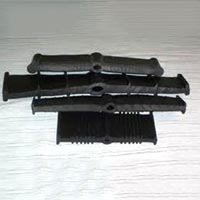- +91-9998005608, +91-9879618567
- atuljani@gayatrigeosynthetics.com
A Waterstop Bar is an essential geotechnical product designed to provide reliable waterproofing and sealing at construction joints, especially in concrete structures. Typically made of rubber, PVC, or other resilient materials, waterstop bars are installed within concrete to prevent the infiltration of water through construction joints and cracks, ensuring the long-term integrity and durability of the structure. Waterstop Bars are particularly effective in water-retaining structures such as dams, reservoirs, swimming pools, tunnels, foundations, and basements, where waterproofing is critical to protect against water damage and seepage.

The primary function of a Waterstop Bar is to act as a barrier to water migration at the joints between concrete sections. During the curing process, when two concrete pours meet, they often leave a gap or seam that may eventually allow water to penetrate. Waterstop Bars are strategically placed in these joints to provide a continuous seal, preventing water from entering the structure. They are designed to expand when exposed to water, effectively sealing the joint and preventing water passage, even in the event of shifting or settling.
Waterstop Bars come in various shapes and sizes, depending on the specific application and type of joint they are meant to seal. Commonly, these bars are installed in construction joints where concrete sections meet, such as at wall-to-floor junctions, base slabs, or between segments of tunnel linings. They are often used in conjunction with other waterproofing methods like geomembranes or coatings for enhanced protection.
A key advantage of using Waterstop Bars is their ability to adapt to movement in the concrete. Many waterstop bars feature an expansion capability, allowing them to swell when exposed to water, creating a tighter seal over time. This feature makes them ideal for structures that are subjected to shifting, settling, or vibration. Their durable and flexible construction also helps maintain the integrity of the joint, ensuring that the water barrier remains intact and effective for years.
| Business Type | Manufacturer, Exporter |
|---|---|
| Payment Terms | L/C, T/T |
Geotextile is permeable flexible membrane a fabric like continues sheet of woven / non woven.We are leading manufacturers of PVC Waterstop and are supplying our product to Govt-semiGovt, Infrastructure projects, Power plant, Refineries, Fertilizer plant, Civil contractors and other agencies. Our product is approved by SSNL, IGNP, NTPC, EIL and other consultant of repute.
Our present range of manufacturing, (RIBBED Type, DUMBBELL Type and KIKER Type ), 150 mm wide X 4-5 mm thick, 150 mm wide X 6 mm thick, 150 mm wide X 8-11 mm thick, 225 mm wide X 4-5 mm thick, 225 mm wide X 6 mm thick, 225 mm wide X 8-11 mm thick, 305 mm wide X 9-12 mm thick.
WATERSTOPS can be welded with a thermostatically controlled heating or blade welder which is able to adjust the heat up to 250°C for melting the PVC WATERSTOPS as following procedure: Cut Water stops ends straight and true using sharp knife or carbide tipped saw blade. Clean and lightly rough up the WATERSTOPS using wire brush. Preheat the blade welder to 250°C then apply on the cut surface of each end. Allow the PVC WATERSTOPS melt down about 4-5 mm. along each cut surface.
Take off the blade welder from the cut surface and hand press neatly each cut surface of WATERSTOPS together. Then check whether the splice was done properly or not by observing no hole, no distortion and, homogeneous. When the splice cooled, observe it carefully again to make sure proper splice, then the spliced WATERSTOPS are ready are ready to be installed. All center bulb waterstop must be aligned.



